The Craziest Experiments Carried Out On Humans
By Molly
1 year ago

 Image Source/Online PsychologyCarried out in 1932, the U.S. Public Health Service began to study the natural history of syphilis. The study involved 600 black men, 399 with the disease and 201 without. Consent from participants was not collected. The experiment involved blood tests, x-rays and spinal taps. The study was ethically and morally wrong due to the lack of consent and racism which took place, as well as lying about the aim of the study itself.
Image Source/Online PsychologyCarried out in 1932, the U.S. Public Health Service began to study the natural history of syphilis. The study involved 600 black men, 399 with the disease and 201 without. Consent from participants was not collected. The experiment involved blood tests, x-rays and spinal taps. The study was ethically and morally wrong due to the lack of consent and racism which took place, as well as lying about the aim of the study itself. Image Source/Online PsychologyThe Monster Study was performed on 22 orphans in 1939. Conducted by Wendell Johnson, half the children would receive positive speech therapy, whilst the other half received negative speech therapy. Many of the normal speaking children who received negative therapy suffered serious psychological affects, some retained speech problems for the rest of their lives.
Image Source/Online PsychologyThe Monster Study was performed on 22 orphans in 1939. Conducted by Wendell Johnson, half the children would receive positive speech therapy, whilst the other half received negative speech therapy. Many of the normal speaking children who received negative therapy suffered serious psychological affects, some retained speech problems for the rest of their lives. Image Source/Online PsychologyUnit 731 was a covert biological and chemical warfare research base, engaging in lethal human experiment. Unit 731 operated during the second Sino-Japanese war and World War II. Human test subjects would be dehumanised and referred to as 'logs', with victims including babies, children and pregnant mothers. The estimates of those killed by Unit 731 and its related programs range up to half a million people.
Image Source/Online PsychologyUnit 731 was a covert biological and chemical warfare research base, engaging in lethal human experiment. Unit 731 operated during the second Sino-Japanese war and World War II. Human test subjects would be dehumanised and referred to as 'logs', with victims including babies, children and pregnant mothers. The estimates of those killed by Unit 731 and its related programs range up to half a million people. Image Source/Online PsychologyThe experiments of Josef Mengele on Jewish twins in concentration camps was to find ways to increase German reproductive rates. He performed experiments on nearly 1500 sets of imprisoned twins at Auschwitz. His experiments would consist of amputations and injecting dyes into their eyes. He also attempted to create conjoined twins by sewing twins together.
Image Source/Online PsychologyThe experiments of Josef Mengele on Jewish twins in concentration camps was to find ways to increase German reproductive rates. He performed experiments on nearly 1500 sets of imprisoned twins at Auschwitz. His experiments would consist of amputations and injecting dyes into their eyes. He also attempted to create conjoined twins by sewing twins together. Image Source/Online PsychologyConducted in 1971, the Stanford prison experiment was designed to examine the effects of situational variables on participants. Participants would be recruited, then randomly assigned to be prisoners or guards. Over time the guards become psychologically and physically abusive towards the prisoners, resulting in the experiment ending after 6 days.
Image Source/Online PsychologyConducted in 1971, the Stanford prison experiment was designed to examine the effects of situational variables on participants. Participants would be recruited, then randomly assigned to be prisoners or guards. Over time the guards become psychologically and physically abusive towards the prisoners, resulting in the experiment ending after 6 days. Image Source/Online PsychologyThe Aversion Project was led during the apartheid, and was a medical torture programme in South Africa. Gay soldiers would be identified as conscripts, as at the time homosexuality in the army was banned. The victims would be forced to submit to 'curing' their homosexuality, many undergoing shock therapy, castration and any other forms of 'therapy'. In 1995, the Medical Association of South Africa issued a public apology.
Image Source/Online PsychologyThe Aversion Project was led during the apartheid, and was a medical torture programme in South Africa. Gay soldiers would be identified as conscripts, as at the time homosexuality in the army was banned. The victims would be forced to submit to 'curing' their homosexuality, many undergoing shock therapy, castration and any other forms of 'therapy'. In 1995, the Medical Association of South Africa issued a public apology. Image Source/Online PsychologyProject MK-Ultra was a CIA led experiment in which they intended to develop procedures and identify drugs such as LSD that would weaken individuals, forcing confessions. MK-Ultra would essentially use brainwashing and psychological torture to obtain confessions. The study began in 1953 and was later halted in 1973.
Image Source/Online PsychologyProject MK-Ultra was a CIA led experiment in which they intended to develop procedures and identify drugs such as LSD that would weaken individuals, forcing confessions. MK-Ultra would essentially use brainwashing and psychological torture to obtain confessions. The study began in 1953 and was later halted in 1973. Image Source/Online PsychologyDespite being a controlled experiment, it was ethically questionable. The Stateville Penitentiary malaria study assessed the effects of malaria on the prisoners during the 1940s. The study was coercive as it lowered sentences for the prisoners. The study is notable due to the impacts it had on the Nuremberg Medical Trial, as well as subsequent medical experimentation of prisoners.
Image Source/Online PsychologyDespite being a controlled experiment, it was ethically questionable. The Stateville Penitentiary malaria study assessed the effects of malaria on the prisoners during the 1940s. The study was coercive as it lowered sentences for the prisoners. The study is notable due to the impacts it had on the Nuremberg Medical Trial, as well as subsequent medical experimentation of prisoners. Image Source/Online PsychologyThe Little Albert experiment, carried out by John Watson in 1920, was a controlled experiment to try and show that emotional reactions could be classically controlled in people. Albert would be exposed to a white rat, in which he initially showed no fear. The next time he showed the white rat, Watson paired it with loud banging of a metal pipe and hammer. Albert began to cry, and later just the white rat would set him off crying.
Image Source/Online PsychologyThe Little Albert experiment, carried out by John Watson in 1920, was a controlled experiment to try and show that emotional reactions could be classically controlled in people. Albert would be exposed to a white rat, in which he initially showed no fear. The next time he showed the white rat, Watson paired it with loud banging of a metal pipe and hammer. Albert began to cry, and later just the white rat would set him off crying. Image Source/Online PsychologyDuring the golden era of scientific enquiry, 3rd century BCE, Alexandria was the hub of knowledge and discovery. Herophilus, who was known as the 'farther of anatomy', was the first known person to dissect human bodies. At Alexandria, he gained unspeakable accusations of performing vivisections on live humans, alongside Erasistratus. His gruesome practice ensured disection of the human body was banned until the Renaissance.
Image Source/Online PsychologyDuring the golden era of scientific enquiry, 3rd century BCE, Alexandria was the hub of knowledge and discovery. Herophilus, who was known as the 'farther of anatomy', was the first known person to dissect human bodies. At Alexandria, he gained unspeakable accusations of performing vivisections on live humans, alongside Erasistratus. His gruesome practice ensured disection of the human body was banned until the Renaissance.
 Image Source/Online PsychologyThe Burke and hare murders were a series of sixteen killings committed in 1828 in Edinburgh. The murders were undertaken for the corpses to be sold to Robert Knox for dissection at his anatomy lectures. During this time, Scottish law required the corpses used for medical research must only be obtained from suicide victims, prisoners who had died or orphans.
Image Source/Online PsychologyThe Burke and hare murders were a series of sixteen killings committed in 1828 in Edinburgh. The murders were undertaken for the corpses to be sold to Robert Knox for dissection at his anatomy lectures. During this time, Scottish law required the corpses used for medical research must only be obtained from suicide victims, prisoners who had died or orphans. Image Source/Online PsychologyJames Marion Sims, regarded as the 'farther of gynaecology', became known for his experimental work on slave women. Sims still remains a controversial figure to this day due to his horrific treatment of his women. He would perform his experiments without anaesthesia, as he stated the operations were 'not painful enough to justify the trouble', which he was believed to have said in a lecture according to NPR.
Image Source/Online PsychologyJames Marion Sims, regarded as the 'farther of gynaecology', became known for his experimental work on slave women. Sims still remains a controversial figure to this day due to his horrific treatment of his women. He would perform his experiments without anaesthesia, as he stated the operations were 'not painful enough to justify the trouble', which he was believed to have said in a lecture according to NPR. Image Source/Online PsychologyDuring the 1960s and 1970s, Peter Neubauer led a secret experiment where they separated twins and triplets from each other and adopted them out as single children. The experiment came to light once a set of three identical triplets found each other in 1980. They had no idea they were triplets at the time. Neubauer showed no remorse for his study, however those experimented on were angered and felt robbed of all their time together.
Image Source/Online PsychologyDuring the 1960s and 1970s, Peter Neubauer led a secret experiment where they separated twins and triplets from each other and adopted them out as single children. The experiment came to light once a set of three identical triplets found each other in 1980. They had no idea they were triplets at the time. Neubauer showed no remorse for his study, however those experimented on were angered and felt robbed of all their time together. Image Source/Online PsychologyDuring World War II, scientists tested mustard gas on 60,000 American soldiers. The tests were funded by the U.S. government and were reportedly in preparation for potential chemical warfare. Officially the tests were to test the effectiveness of new clothing and protective gear against the deadly gas, which had been so devastating in the First World War.
Image Source/Online PsychologyDuring World War II, scientists tested mustard gas on 60,000 American soldiers. The tests were funded by the U.S. government and were reportedly in preparation for potential chemical warfare. Officially the tests were to test the effectiveness of new clothing and protective gear against the deadly gas, which had been so devastating in the First World War. Image Source/Online PsychologyDuring the 1940s, researchers at Vanderbilt University gave radioactive pills to pregnant women. It's believed 751 pregnant women were given these pills which exposed them and their fetuses to radiation 30 times higher than natural background radiation. A follow-up study in the 1960s concluded three of the children born to these women likely died because of the research.
Image Source/Online PsychologyDuring the 1940s, researchers at Vanderbilt University gave radioactive pills to pregnant women. It's believed 751 pregnant women were given these pills which exposed them and their fetuses to radiation 30 times higher than natural background radiation. A follow-up study in the 1960s concluded three of the children born to these women likely died because of the research. Image Source/Online PsychologyIn 1965, a Canadian, David Peter Reimer lost his penis during an unconventional circumcision by cauterization at only 7 months old. John Money, who was a psychologist and believed the idea of gender was learned, tried convincing the Reimers that their biological son could be more successful and sexually mature as a girl. Reimer later reported that he never identified as a girl, he spent his teen years depressed and later killed himself aged 38.
Image Source/Online PsychologyIn 1965, a Canadian, David Peter Reimer lost his penis during an unconventional circumcision by cauterization at only 7 months old. John Money, who was a psychologist and believed the idea of gender was learned, tried convincing the Reimers that their biological son could be more successful and sexually mature as a girl. Reimer later reported that he never identified as a girl, he spent his teen years depressed and later killed himself aged 38. Image Source/Online PsychologyDuring the 1950s, mentally handicapped children who attended Willowbrook State School in New York began experiencing outbreaks of hepatitis. The unsanitary conditions meant it was almost inevitable the kids would develop the disease. Dr Saul Krugman began an experiment to solve this by purposely injecting the children with the disease. Although critics questioned the morality, many parents signed consent in order for their kids to get a place at the school.
Image Source/Online PsychologyDuring the 1950s, mentally handicapped children who attended Willowbrook State School in New York began experiencing outbreaks of hepatitis. The unsanitary conditions meant it was almost inevitable the kids would develop the disease. Dr Saul Krugman began an experiment to solve this by purposely injecting the children with the disease. Although critics questioned the morality, many parents signed consent in order for their kids to get a place at the school.
 Image Source/Online PsychologyHaving been a surgeon in the U.S. Army, Beaumont become known as the 'Farther of Gastric Physiology'. Beaumont conducted hundreds of experiments on the functions of the human stomach. Beaumont made the majority of his experiments on Alexis St. Martin, a long-time patient of his with a peculiar abdominal wound. He would keep food on a string, whilst watching the stomach absorb it, often causing St. Martin severe pain.
Image Source/Online PsychologyHaving been a surgeon in the U.S. Army, Beaumont become known as the 'Farther of Gastric Physiology'. Beaumont conducted hundreds of experiments on the functions of the human stomach. Beaumont made the majority of his experiments on Alexis St. Martin, a long-time patient of his with a peculiar abdominal wound. He would keep food on a string, whilst watching the stomach absorb it, often causing St. Martin severe pain. Image Source/Online PsychologyFrom 1965 to 1966, the U.S. army funded Dr Albert Kligman, who carried out "dermatological research" on approximately 75 prisoners. What was really being tested was the effects of Agent Orange on humans. Agent Orange was a terrible weapon used in the Vietnam War which caused serious skin conditions and irritation. The prisoners suffered long after the tests were undertaken.
Image Source/Online PsychologyFrom 1965 to 1966, the U.S. army funded Dr Albert Kligman, who carried out "dermatological research" on approximately 75 prisoners. What was really being tested was the effects of Agent Orange on humans. Agent Orange was a terrible weapon used in the Vietnam War which caused serious skin conditions and irritation. The prisoners suffered long after the tests were undertaken. Image Source/Online PsychologyLike many previous experiments, Prisoners seem to be the victim. This is no different in the Cold War, where the Soviet Secret Police conducted poison experiments in Soviet gulags. The Soviet's ambition was to develop a fatal gas which was both tasteless and doorless. These experiments took place in 'The Chamber' where the prisoner were forcefully given unknown doses of mustard gas, ricin and other concoctions.
Image Source/Online PsychologyLike many previous experiments, Prisoners seem to be the victim. This is no different in the Cold War, where the Soviet Secret Police conducted poison experiments in Soviet gulags. The Soviet's ambition was to develop a fatal gas which was both tasteless and doorless. These experiments took place in 'The Chamber' where the prisoner were forcefully given unknown doses of mustard gas, ricin and other concoctions. Image Source/Online PsychologyFollowing the explosion from the Castle Bravo nuclear tests at Bikini Atoll in 1952, rather than informing the residents of the Marshall Islands of the radiation and treating them, the U.S. decided to study them. The results from the first decade were inconclusive, however by 1974 almost a third of the exposed islanders developed tumors.
Image Source/Online PsychologyFollowing the explosion from the Castle Bravo nuclear tests at Bikini Atoll in 1952, rather than informing the residents of the Marshall Islands of the radiation and treating them, the U.S. decided to study them. The results from the first decade were inconclusive, however by 1974 almost a third of the exposed islanders developed tumors.
 Image Source/Online PsychologyIt became apparent in the 1940s that Tuskegee's black people were not the only victims of inhumane testing of diseases. The Guatemalans were also deemed suitable by the U.S. government as their guinea pigs. Approximately 1,500 Guatemalan prisoners were infected with syphilis, resulting in more than 80 deaths.
Image Source/Online PsychologyIt became apparent in the 1940s that Tuskegee's black people were not the only victims of inhumane testing of diseases. The Guatemalans were also deemed suitable by the U.S. government as their guinea pigs. Approximately 1,500 Guatemalan prisoners were infected with syphilis, resulting in more than 80 deaths.
 Image Source/Online PsychologyNorth Korea has a shady reputation when it comes to human experimentation. Numerous defectors have all claimed to witness disturbing accounts of human experimentation. One of these alleged experiments consisted of giving 50 healthy female prisoners poisoned cabbage leaves, all 50 were then dead only 20 minutes later.
Image Source/Online PsychologyNorth Korea has a shady reputation when it comes to human experimentation. Numerous defectors have all claimed to witness disturbing accounts of human experimentation. One of these alleged experiments consisted of giving 50 healthy female prisoners poisoned cabbage leaves, all 50 were then dead only 20 minutes later. Image Source/Online PsychologyThe Vipeholm Experiment was a series of experiments between 1945 to 1955 testing the effects of sugar to dental cavities. The patients would be force fed large amounts of sugary foods, resulting in many of them having permanent tooth damage. The people undergoing the experiment were mentally and intellectually disabled, causing many people to question the ethics of the experiment.
Image Source/Online PsychologyThe Vipeholm Experiment was a series of experiments between 1945 to 1955 testing the effects of sugar to dental cavities. The patients would be force fed large amounts of sugary foods, resulting in many of them having permanent tooth damage. The people undergoing the experiment were mentally and intellectually disabled, causing many people to question the ethics of the experiment. Image Source/Online PsychologyThe U.S. Army was responsible for numerous biological warfare experiments between 1956 and 1957 in the cities of Savannah, Georgia and Avon Park, Florida. One of these experiments consisted of millions of infected mosquitos, which were released into two of the cities. The aim was to see if they could spread yellow fever and dengue fever. No surprise, this led to thousands of researches becoming infected.
Image Source/Online PsychologyThe U.S. Army was responsible for numerous biological warfare experiments between 1956 and 1957 in the cities of Savannah, Georgia and Avon Park, Florida. One of these experiments consisted of millions of infected mosquitos, which were released into two of the cities. The aim was to see if they could spread yellow fever and dengue fever. No surprise, this led to thousands of researches becoming infected. Image source/ SexandpsychologySociologist Laud Humphrey's broke down some societal stereotypes when he researched men who commit acts of a sexual nature in public restrooms 'tearoom sex'. He wanted to understand by it led to so many homosexual arrests and he found that the majority of his subjects were married heterosexual men. It was totally unethical due to the fact he was observing intimate acts without consent.
Image source/ SexandpsychologySociologist Laud Humphrey's broke down some societal stereotypes when he researched men who commit acts of a sexual nature in public restrooms 'tearoom sex'. He wanted to understand by it led to so many homosexual arrests and he found that the majority of his subjects were married heterosexual men. It was totally unethical due to the fact he was observing intimate acts without consent. Image source/ TheNewYorkTimesDermatologist Dr. Albert Kilgman began experimenting on inmates at Philadelphia's Holmesburg prison. For 20 years, inmates allowed him to experiment on them using their skin to test creams/shampoos/detergents etc. The tests required continous biopsies but the inmates suffered no long-term harm despite the fact that the experiment wasn't considered ethical.
Image source/ TheNewYorkTimesDermatologist Dr. Albert Kilgman began experimenting on inmates at Philadelphia's Holmesburg prison. For 20 years, inmates allowed him to experiment on them using their skin to test creams/shampoos/detergents etc. The tests required continous biopsies but the inmates suffered no long-term harm despite the fact that the experiment wasn't considered ethical. Image source/ History.comHenrietta Lacks made a ground-breaking contribution to science when her cells were used to develop things such as the Polio vaccine, AIDS research, gene-mapping. Other cells had never managed to be kept alive before. She was totally unaware that her cells had been used and she died completely penniless and her family were also kept in the dark for decades.
Image source/ History.comHenrietta Lacks made a ground-breaking contribution to science when her cells were used to develop things such as the Polio vaccine, AIDS research, gene-mapping. Other cells had never managed to be kept alive before. She was totally unaware that her cells had been used and she died completely penniless and her family were also kept in the dark for decades. Image source/ The SunThe CIA were conducting an experiment based on Chinese brain-washing techniques to develop new methods of interrogation. Dr. Harold G. Wolf was leading the research and he requested that the CIA provided subjects for his so that he could test on humans...
Image source/ The SunThe CIA were conducting an experiment based on Chinese brain-washing techniques to develop new methods of interrogation. Dr. Harold G. Wolf was leading the research and he requested that the CIA provided subjects for his so that he could test on humans... Image source/ PinterestSigmund Freud had a lot of out-there theories. He decided to declare that Emma Eckstein needed to be treated for her complaints of slight stomach discomfort and mild depressive thoughts. He told her she was hysterical and had to have a section of the inside of her nose cauterised. He anesthezised her with only local anesthetic and cocaine and insisted on treating her for 3 years as an experiment.
Image source/ PinterestSigmund Freud had a lot of out-there theories. He decided to declare that Emma Eckstein needed to be treated for her complaints of slight stomach discomfort and mild depressive thoughts. He told her she was hysterical and had to have a section of the inside of her nose cauterised. He anesthezised her with only local anesthetic and cocaine and insisted on treating her for 3 years as an experiment. Image source/ thecleo.comDr. Lauretta Bender claimed to have the answer to children's social issues with a new revolutionary technique - electro-shocks. During her time she completed it on around 100 children, the youngest of whom was 3 years old before having her research finally shut down altogether.
Image source/ thecleo.comDr. Lauretta Bender claimed to have the answer to children's social issues with a new revolutionary technique - electro-shocks. During her time she completed it on around 100 children, the youngest of whom was 3 years old before having her research finally shut down altogether. Image source/ Cracked.comIn California in the 1960s the University of California started experimenting on newborn babies to study blood pressure and flow. They would insert uncomfortable tubes inside the babies as catheters, immerse their feet in ice water, strap them onto circumcision boards and tilt them so that blood rushed to their heads.
Image source/ Cracked.comIn California in the 1960s the University of California started experimenting on newborn babies to study blood pressure and flow. They would insert uncomfortable tubes inside the babies as catheters, immerse their feet in ice water, strap them onto circumcision boards and tilt them so that blood rushed to their heads. Image source/ History of yesterdayDr. Leo Stanford carried out a series of bizarre medical experiments on the inmates at San Quentin prison. These included things such as sterilisation, and potential treatments for the Spanish flu. And, he even performed testicle transplants on some of the prisoners using living inmates using the testicles of those who had been executed.
Image source/ History of yesterdayDr. Leo Stanford carried out a series of bizarre medical experiments on the inmates at San Quentin prison. These included things such as sterilisation, and potential treatments for the Spanish flu. And, he even performed testicle transplants on some of the prisoners using living inmates using the testicles of those who had been executed. The bystander effect was researched after people had witnessed a murder and not done anything to help/ report it. People were put in a room and asked to fill out a form, they didn't know that smoke would seep into the room to test whether they reported it. They found that those alone were much quicker and likely to than those in a group.
The bystander effect was researched after people had witnessed a murder and not done anything to help/ report it. People were put in a room and asked to fill out a form, they didn't know that smoke would seep into the room to test whether they reported it. They found that those alone were much quicker and likely to than those in a group. Image source/ The conversationJane Elliot wanted to conduct research into the feeling of superiority. She had two groups, one brown-eyed teenage boys, the other blue-eyed teenage boys. She told them that research had shown brown eyes were superior. It took only a day for them to behave more superior and more cruel. She then tried it in reverse. The groups were both deceived which is unethical.
Image source/ The conversationJane Elliot wanted to conduct research into the feeling of superiority. She had two groups, one brown-eyed teenage boys, the other blue-eyed teenage boys. She told them that research had shown brown eyes were superior. It took only a day for them to behave more superior and more cruel. She then tried it in reverse. The groups were both deceived which is unethical.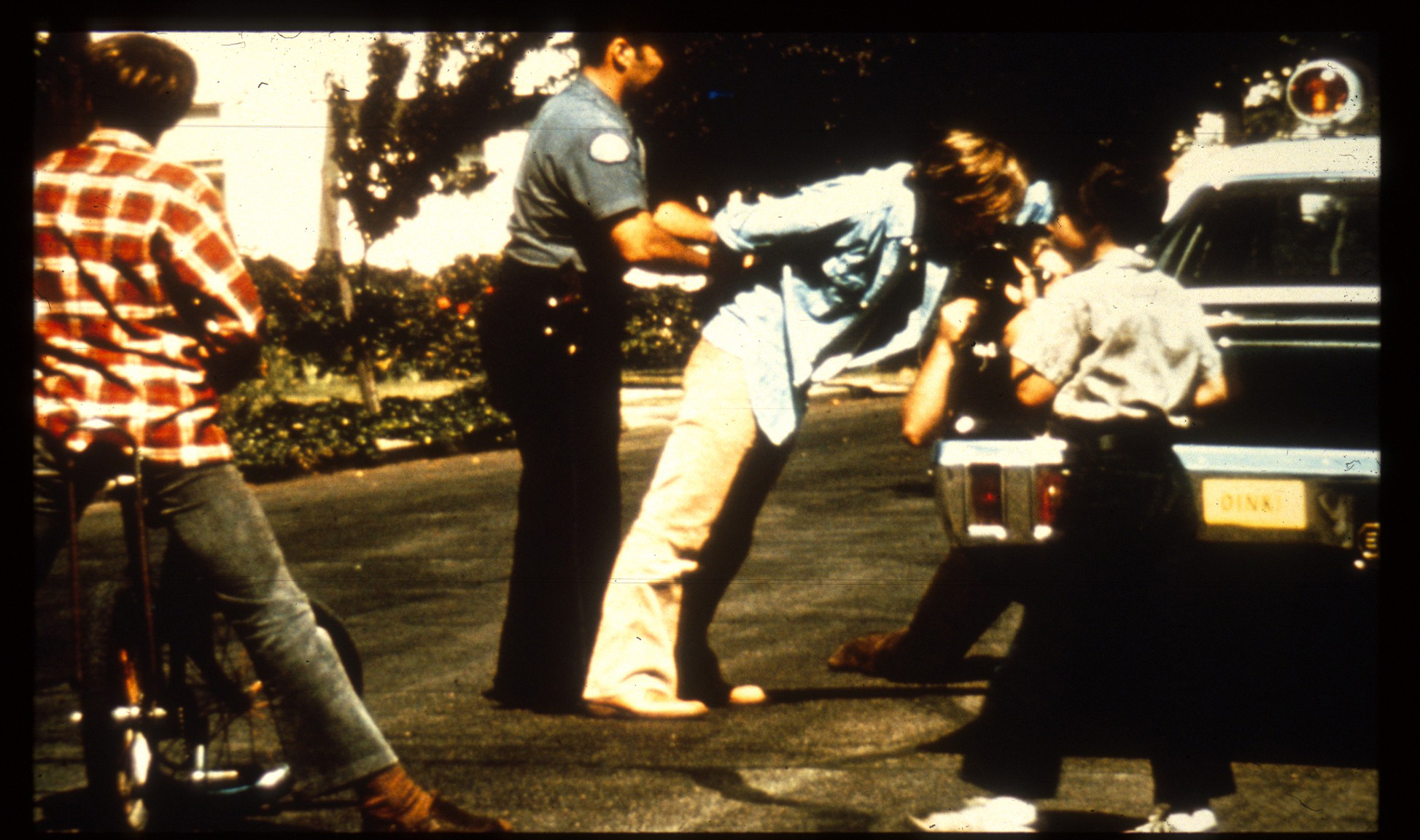 (Image/ Source: prisonexp.org)For the experiment to be as realistic as possible, those who had been assigned the role of a guard would have to simulate an “arrest” for those who would be acting as prisoners. The prisoners were arrested in their own homes, without warning, and taken to the local police station. This is where they would spend the next 2 weeks.
(Image/ Source: prisonexp.org)For the experiment to be as realistic as possible, those who had been assigned the role of a guard would have to simulate an “arrest” for those who would be acting as prisoners. The prisoners were arrested in their own homes, without warning, and taken to the local police station. This is where they would spend the next 2 weeks.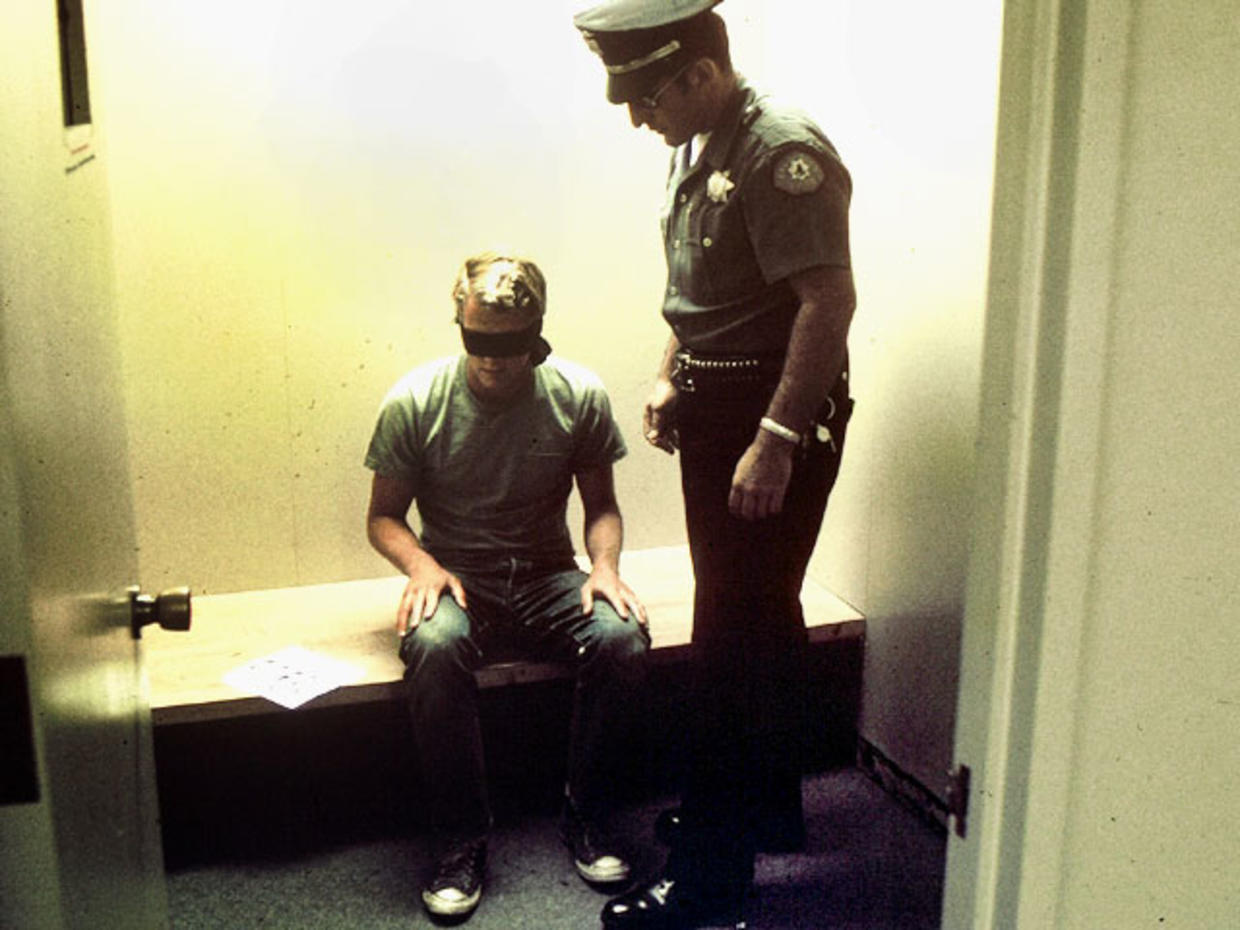 (Image/ Source: cbsnews.com)At the police station, the prisoners were fingerprinted, photographed and “booked” for their alleged charges. After this took place, the prisoners were then given their uniforms and taken to a holding cell to await transportation to the "prison" at Stanford. The prisoners were blindfolded at this stage.
(Image/ Source: cbsnews.com)At the police station, the prisoners were fingerprinted, photographed and “booked” for their alleged charges. After this took place, the prisoners were then given their uniforms and taken to a holding cell to await transportation to the "prison" at Stanford. The prisoners were blindfolded at this stage.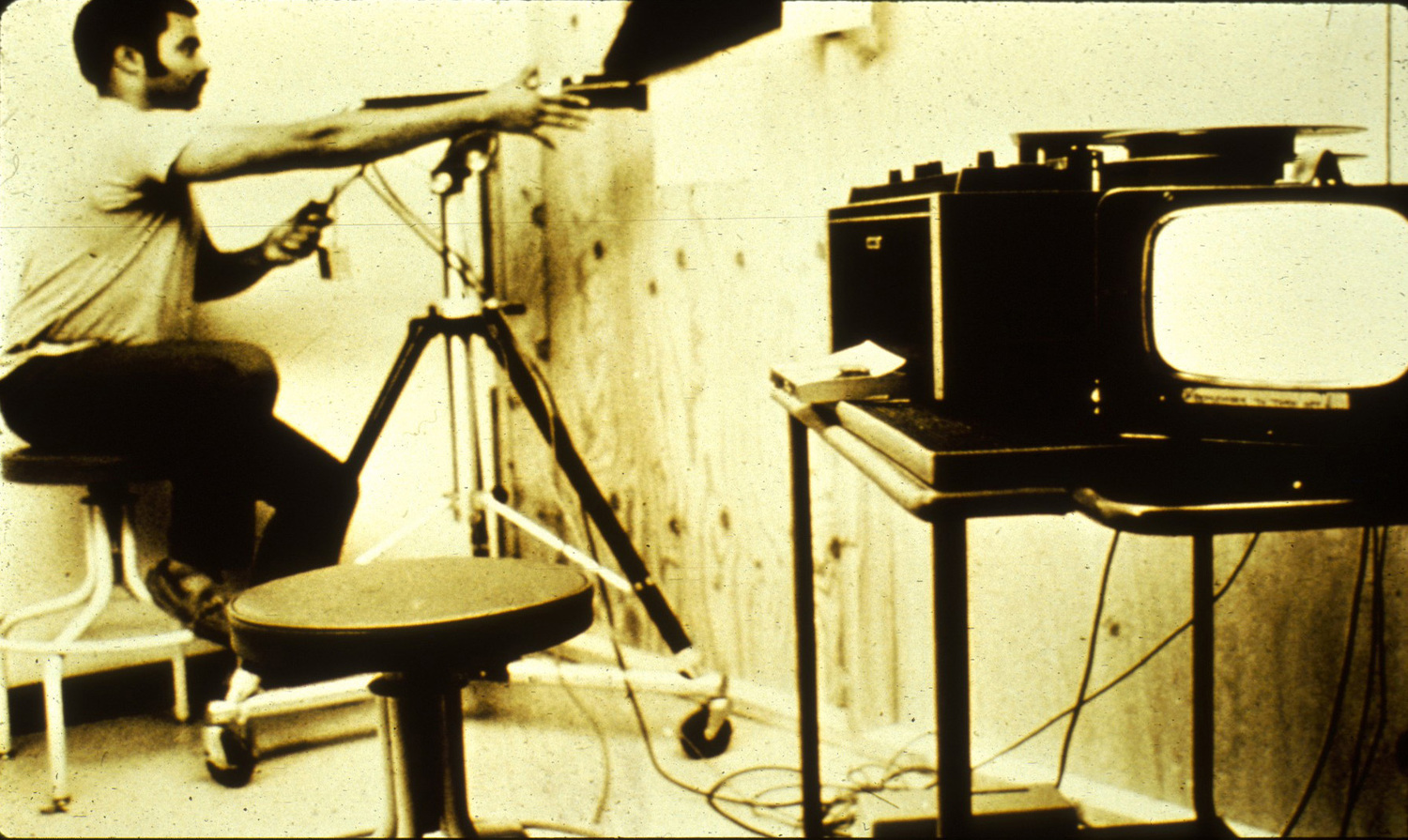 (Image/ Source: prisonexp.org)While the "suspects" were being rounded up, Dr. Phillip G. Zimbardo, who created the experiment, put his team to work as they finished the final touches to the "prison." They nailed bars on cells and set up a closet for solitary confinement - known as "the hole." Real ex-convicts served as consultants to make things as realistic as possible.
(Image/ Source: prisonexp.org)While the "suspects" were being rounded up, Dr. Phillip G. Zimbardo, who created the experiment, put his team to work as they finished the final touches to the "prison." They nailed bars on cells and set up a closet for solitary confinement - known as "the hole." Real ex-convicts served as consultants to make things as realistic as possible. (Image/ Source: britannica.com)Prisoners were then taken to the facility. As they were still blindfolded, they had no idea where the prison was- or what to expect on the other side. As many of them were still reeling from their shock arrest, their journey to the prison itself must have been pretty scary to say the least. But things were about to get worse…
(Image/ Source: britannica.com)Prisoners were then taken to the facility. As they were still blindfolded, they had no idea where the prison was- or what to expect on the other side. As many of them were still reeling from their shock arrest, their journey to the prison itself must have been pretty scary to say the least. But things were about to get worse…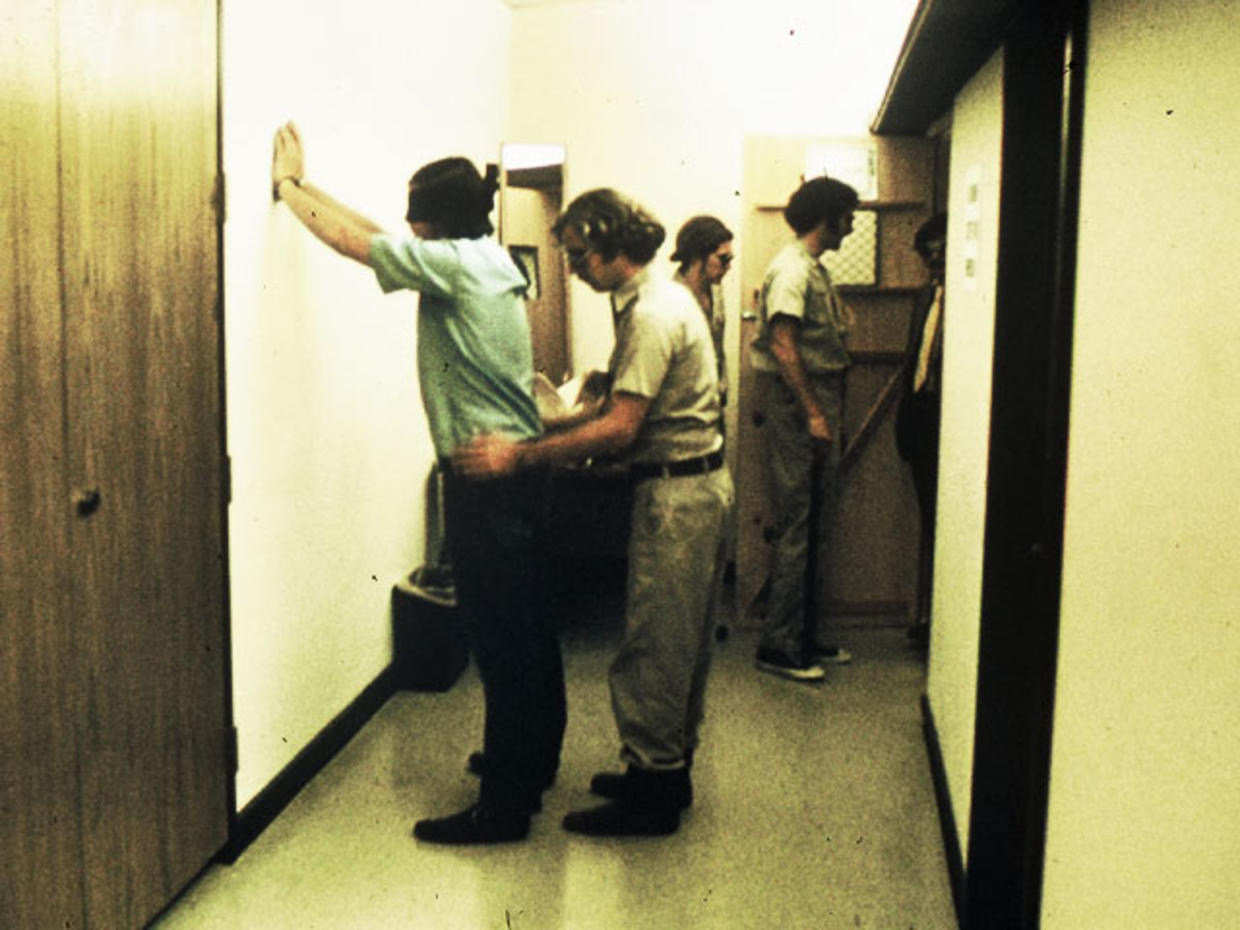 (Image/ Source: cbsnews.com)When they arrived at the facility, the reality of the experiment began to hit home. Prisoners were searched, stripped, and issued a smock with an ID number, stocking cap, and rubber sandals- and each had a chain bolted to his ankle. The chain was used to remind "prisoners" at all times that they were incarcerated and unable to escape.
(Image/ Source: cbsnews.com)When they arrived at the facility, the reality of the experiment began to hit home. Prisoners were searched, stripped, and issued a smock with an ID number, stocking cap, and rubber sandals- and each had a chain bolted to his ankle. The chain was used to remind "prisoners" at all times that they were incarcerated and unable to escape.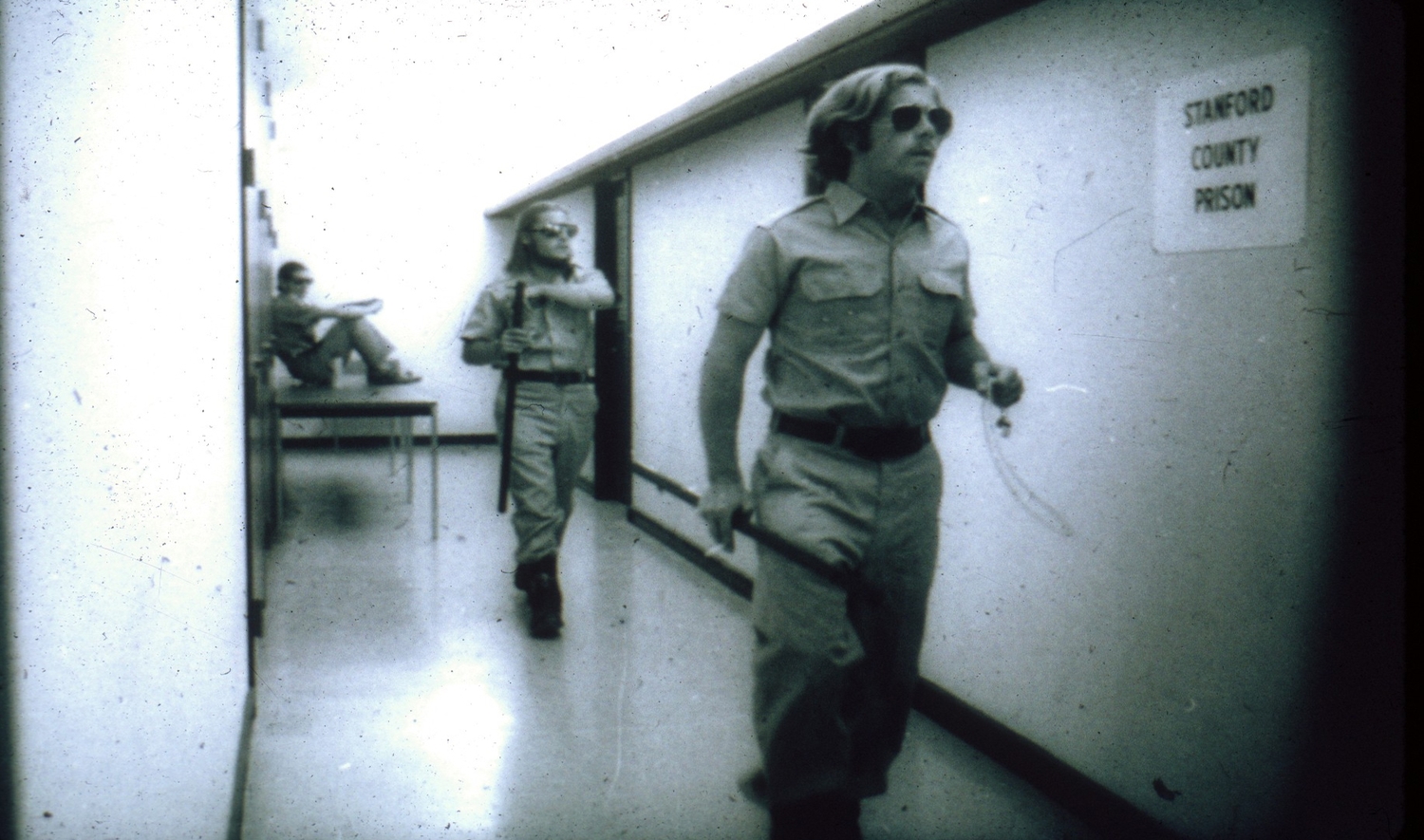 (Image/ Source: prisonexp.org)Guards were kitted out in khakis and mirrored sunglasses, and carried around a whistle and a baton. As all of the “guards” were untrained, the dynamics of the experiment allowed them to do whatever they deemed necessary to maintain law and order. Some of the guards were kind to the prisoners, but others behaved much more sadistically.
(Image/ Source: prisonexp.org)Guards were kitted out in khakis and mirrored sunglasses, and carried around a whistle and a baton. As all of the “guards” were untrained, the dynamics of the experiment allowed them to do whatever they deemed necessary to maintain law and order. Some of the guards were kind to the prisoners, but others behaved much more sadistically.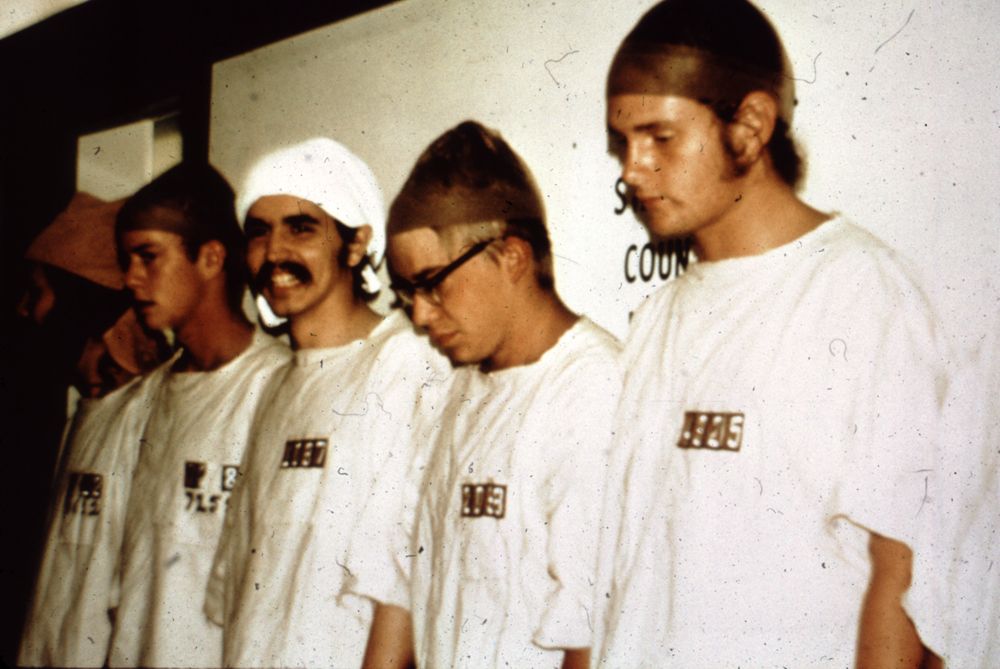 (Image/ Source: insidehighered.com)Prisoners were given their own uniforms. Each of them was dressed in a basic white smock with their number written on it, but no underclothes. They also had a tight nylon cap to cover their hair, but even these became a privilege to wear after a while as the guard’s behaviour became increasingly hostile.
(Image/ Source: insidehighered.com)Prisoners were given their own uniforms. Each of them was dressed in a basic white smock with their number written on it, but no underclothes. They also had a tight nylon cap to cover their hair, but even these became a privilege to wear after a while as the guard’s behaviour became increasingly hostile. (Image/ Source: prisonexp.org)While the guards were not permitted to be physically violent with anyone during the experiment, they decided to come up with some pretty nasty tactics. The first night the prisoners arrived, they decided to wake them up at 2.30 am and made them memorise their prison numbers and do push-ups. And this didn’t go down well with the prisoners at all…
(Image/ Source: prisonexp.org)While the guards were not permitted to be physically violent with anyone during the experiment, they decided to come up with some pretty nasty tactics. The first night the prisoners arrived, they decided to wake them up at 2.30 am and made them memorise their prison numbers and do push-ups. And this didn’t go down well with the prisoners at all… (Image/ Source: prisonexp.org)After the guards’ behaviour, the prisoners decided to fight back- much to the surprise of psychologists. The prisoners barricaded themselves in their cells, ripped off their numbers and caps, and began taunting the guards. The guards quickly retaliated and shot fire extinguishers at the prisoners, and some even had their clothes taken from them.
(Image/ Source: prisonexp.org)After the guards’ behaviour, the prisoners decided to fight back- much to the surprise of psychologists. The prisoners barricaded themselves in their cells, ripped off their numbers and caps, and began taunting the guards. The guards quickly retaliated and shot fire extinguishers at the prisoners, and some even had their clothes taken from them. (Image/ Source: prisonexp.org)At this point, the guards decided to set up a new system. set up a "privilege cell" where the most cooperative "prisoners" got their clothes and beds back and were allowed to wash, brush their teeth, eat, and sleep. But then the guards swapped the troublemakers into the "privilege cells," which confused the prisoners.
(Image/ Source: prisonexp.org)At this point, the guards decided to set up a new system. set up a "privilege cell" where the most cooperative "prisoners" got their clothes and beds back and were allowed to wash, brush their teeth, eat, and sleep. But then the guards swapped the troublemakers into the "privilege cells," which confused the prisoners.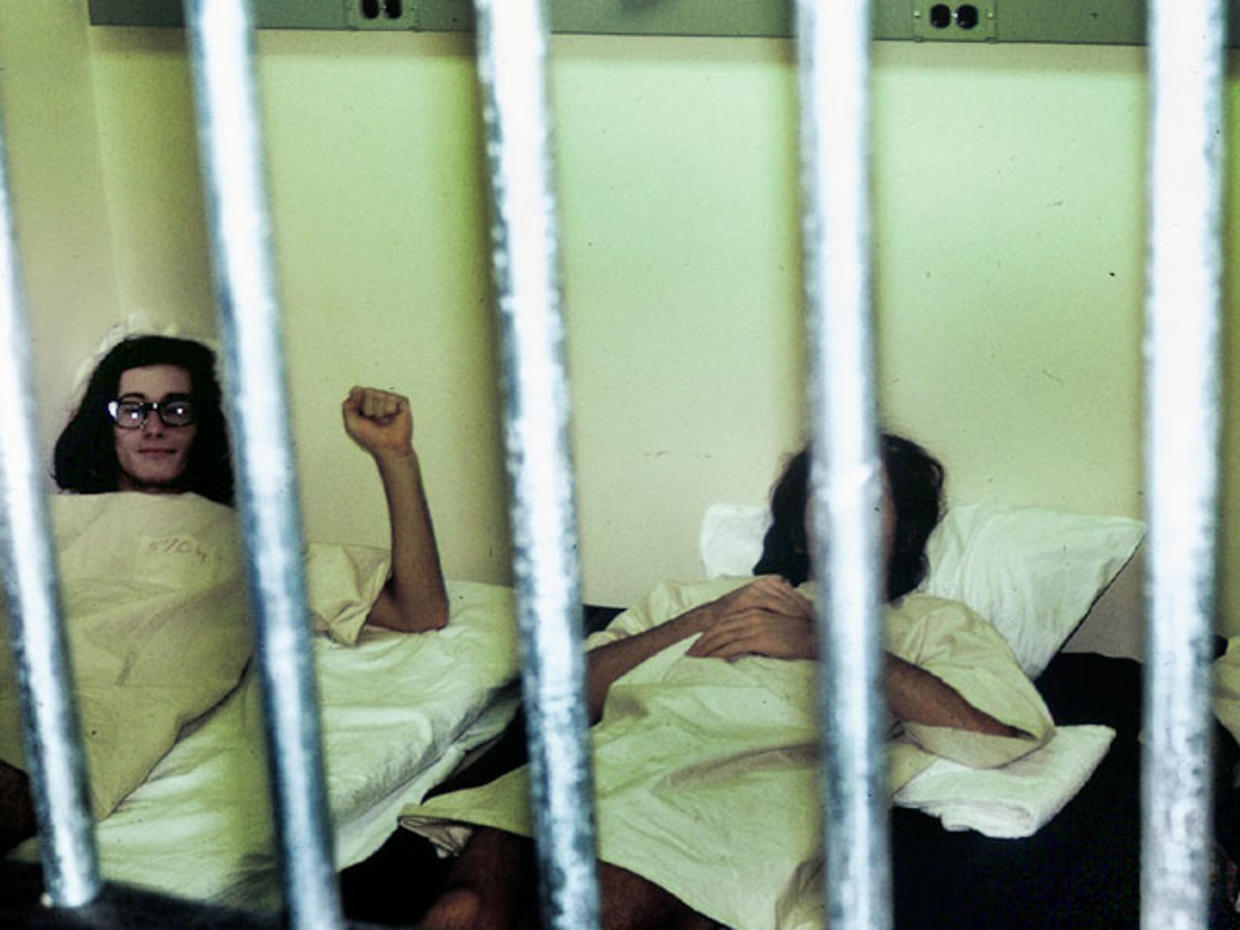 (Image/ Source: cbsnews.com)The prisoners were struggling to keep up with the decisions and behaviours of the guards, but at this point in the experiment, a lot of them were still fairly upbeat. They would wake up in their shared cells each day together, and the chatter between them would help boost their morale when things got tough.
(Image/ Source: cbsnews.com)The prisoners were struggling to keep up with the decisions and behaviours of the guards, but at this point in the experiment, a lot of them were still fairly upbeat. They would wake up in their shared cells each day together, and the chatter between them would help boost their morale when things got tough.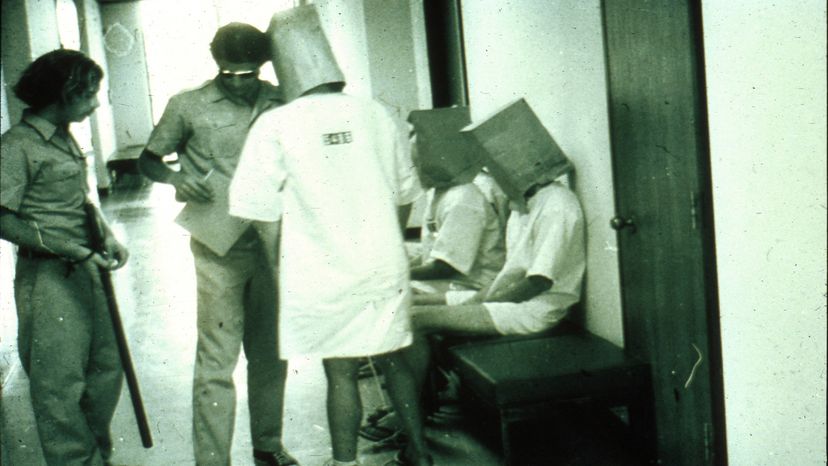 (Image/ Source: science.howstuffworks.com)But the guards continued with their dehumanising tactics, and things got pretty dark. They forced the prisoners to wear bags on their heads as they walked around the facility- which was just one of the horrific methods used by them. Unsurprisingly, the family members of the prisoners started to fear for the mental health of their loved ones.
(Image/ Source: science.howstuffworks.com)But the guards continued with their dehumanising tactics, and things got pretty dark. They forced the prisoners to wear bags on their heads as they walked around the facility- which was just one of the horrific methods used by them. Unsurprisingly, the family members of the prisoners started to fear for the mental health of their loved ones.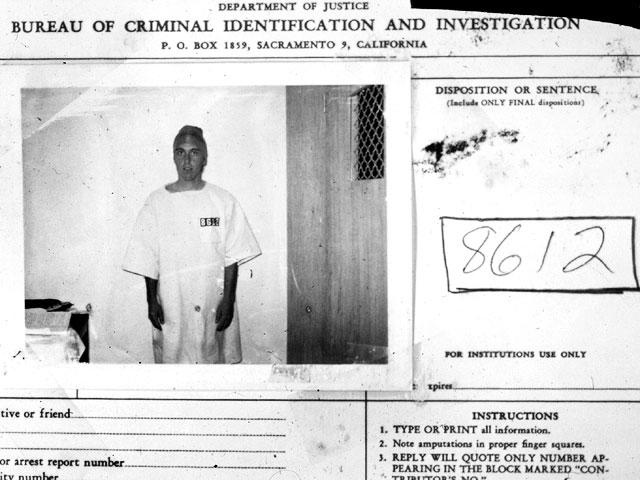 (Image/ Source: cbsnews.com)36 hours into the experiment, prisoner 8612 flew into a desperate rage. As his time in the facility began to take its toll, he feared that he and his fellow prisoners couldn’t quit the experiment. It wasn't true, of course, but this message terrified the other prisoners, who were all convinced that they couldn’t escape.
(Image/ Source: cbsnews.com)36 hours into the experiment, prisoner 8612 flew into a desperate rage. As his time in the facility began to take its toll, he feared that he and his fellow prisoners couldn’t quit the experiment. It wasn't true, of course, but this message terrified the other prisoners, who were all convinced that they couldn’t escape. (Image/ Source: cbsnews.com)Zimbardo decided to set up visiting hours for some of the prisoners’ friends and family. He had the prisoners clean themselves and their cells, and fed them a big meal so worried parents wouldn't insist that their kids leave the study. However, family members continued to express their concerns about the experiment to Zimbardo- but he brushed off their concerns.
(Image/ Source: cbsnews.com)Zimbardo decided to set up visiting hours for some of the prisoners’ friends and family. He had the prisoners clean themselves and their cells, and fed them a big meal so worried parents wouldn't insist that their kids leave the study. However, family members continued to express their concerns about the experiment to Zimbardo- but he brushed off their concerns.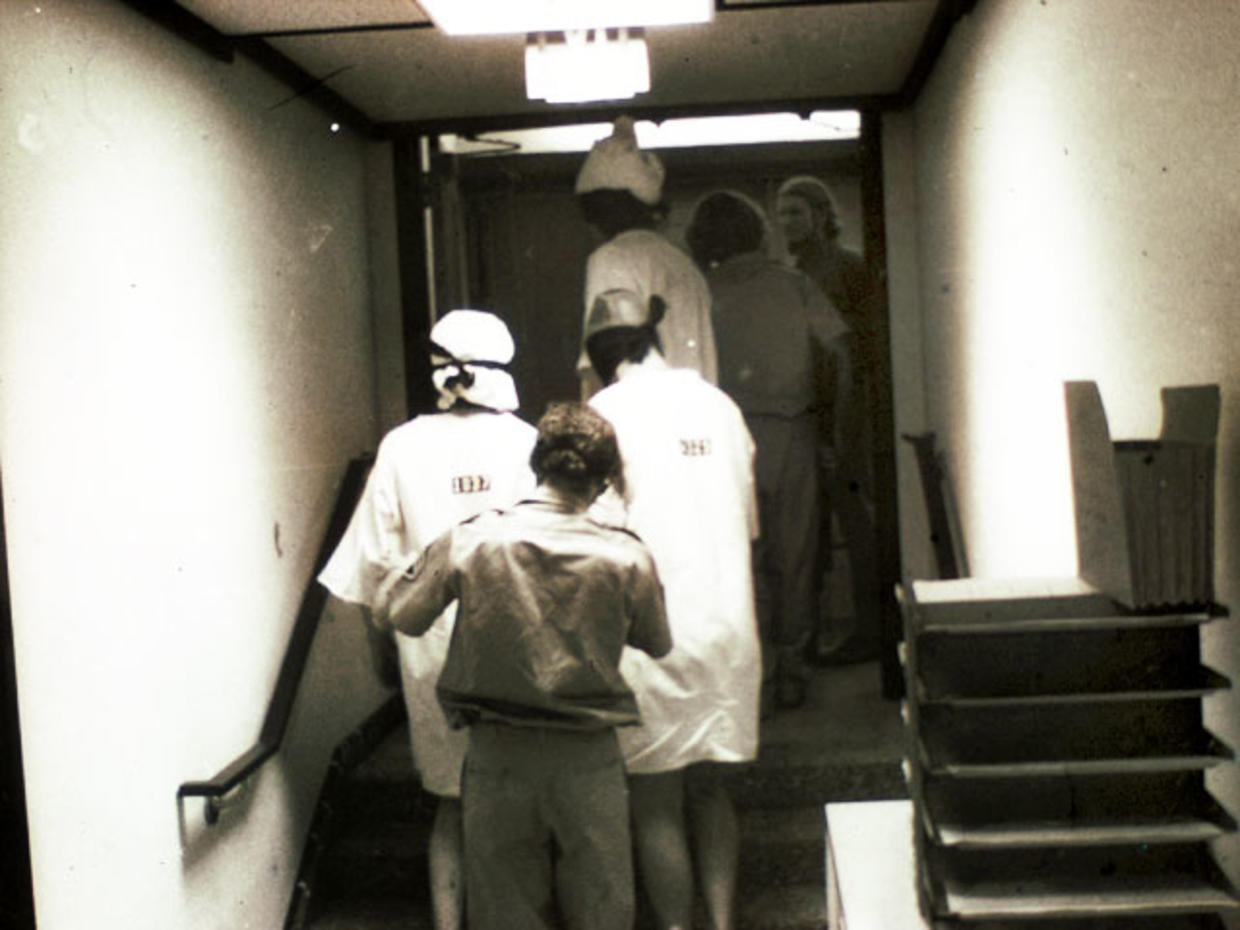 (Image/ Source: cbsnews.com)After his outburst, Prisoner 8612 was released from the experiment, as there were growing fears for his mental health. But Zimbardo and his team still couldn’t be seen as ethical. After rumours grew that Prisoner 8612 would be staging a prison break to free the rest of the prisoners (which wasn’t true) Zimbardo leapt into action. He tried to transfer the prisoners to a real-life prison facility, but he was unsuccessful.
(Image/ Source: cbsnews.com)After his outburst, Prisoner 8612 was released from the experiment, as there were growing fears for his mental health. But Zimbardo and his team still couldn’t be seen as ethical. After rumours grew that Prisoner 8612 would be staging a prison break to free the rest of the prisoners (which wasn’t true) Zimbardo leapt into action. He tried to transfer the prisoners to a real-life prison facility, but he was unsuccessful.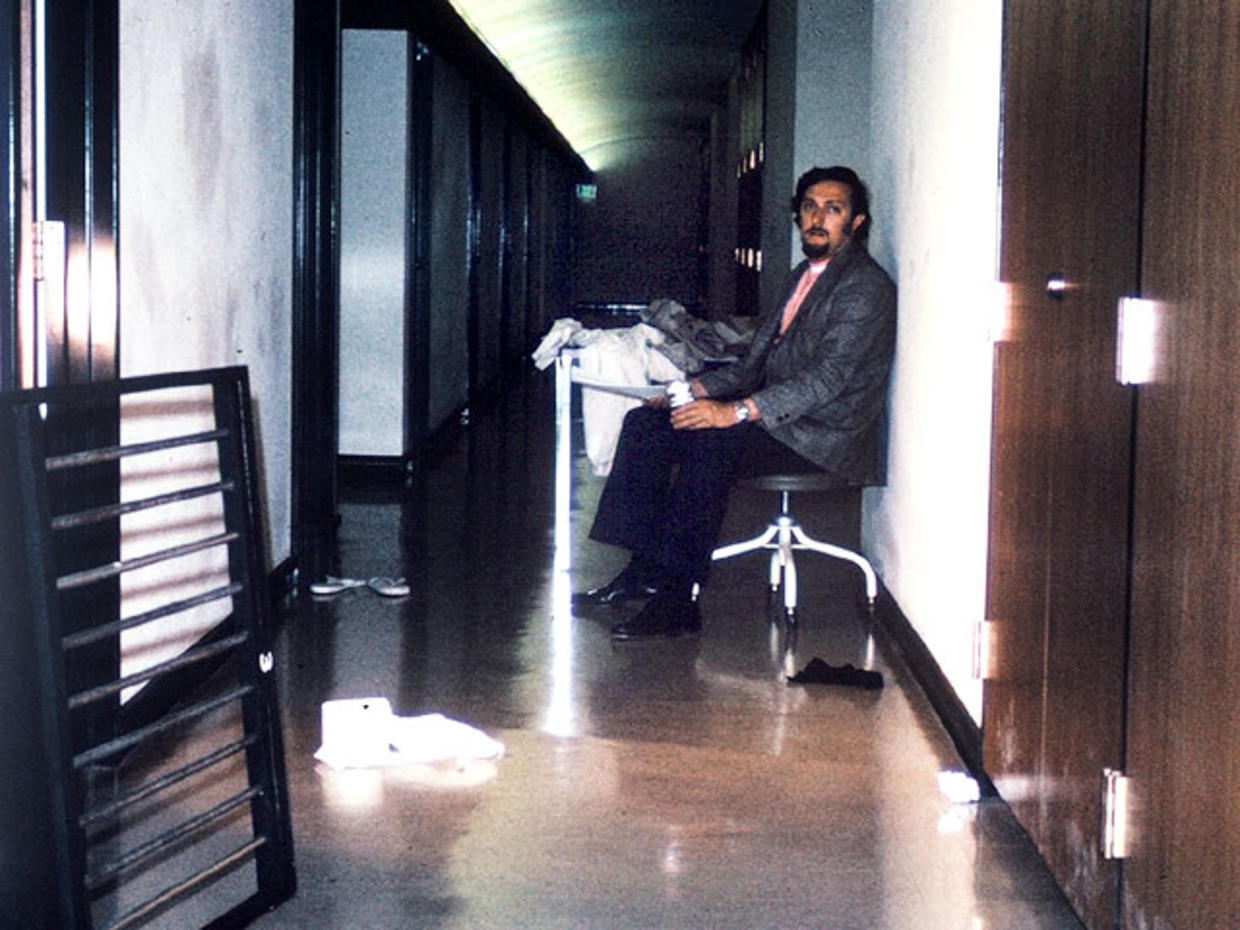 (Image/ Source: cbsnews.com)Zimbardo waited all night, but the alleged prison break never actually happened. At this point, Zimbardo’s own team started to become concerned for him; like his study's participants, he was beginning to blur the lines between the experiment and reality. Zimbardo was acting like an actual prison superintendent, and refused to listen to any more concerned family members.
(Image/ Source: cbsnews.com)Zimbardo waited all night, but the alleged prison break never actually happened. At this point, Zimbardo’s own team started to become concerned for him; like his study's participants, he was beginning to blur the lines between the experiment and reality. Zimbardo was acting like an actual prison superintendent, and refused to listen to any more concerned family members. (Image/ Source: prisonexp.org)Zimbardo’s hysteria rubbed off on a lot of the prison guards, who were continuing to enjoy their power against the prisoners. They forced the prisoners into yet more unpleasant tasks, like intense exercises and scrubbing toilets, which caused a lot of the prisoners to finally break down. But Zimbardo pushed on with the study.
(Image/ Source: prisonexp.org)Zimbardo’s hysteria rubbed off on a lot of the prison guards, who were continuing to enjoy their power against the prisoners. They forced the prisoners into yet more unpleasant tasks, like intense exercises and scrubbing toilets, which caused a lot of the prisoners to finally break down. But Zimbardo pushed on with the study.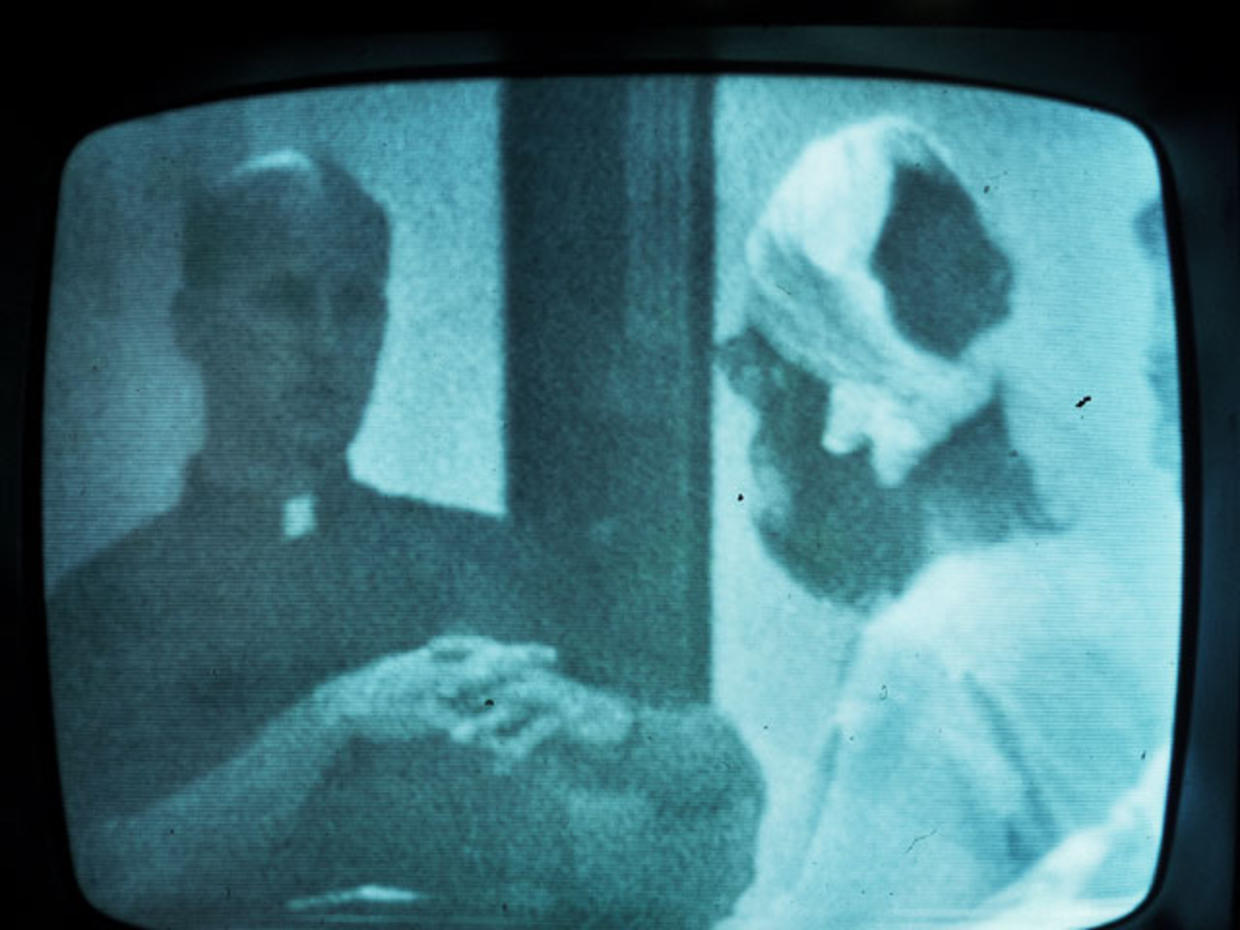 (Image/ Source: cbsnews.com)To make the experiment even more realistic, Zimbardo decided to call a priest in. He was surprised to see the prisoners introduce themselves with their prisoner numbers instead of their names, which showed that they were starting to lose their grip on reality. When the priest asked prisoners why they were in jail, or if they needed a lawyer, some of them actually took the priest up on this.
(Image/ Source: cbsnews.com)To make the experiment even more realistic, Zimbardo decided to call a priest in. He was surprised to see the prisoners introduce themselves with their prisoner numbers instead of their names, which showed that they were starting to lose their grip on reality. When the priest asked prisoners why they were in jail, or if they needed a lawyer, some of them actually took the priest up on this.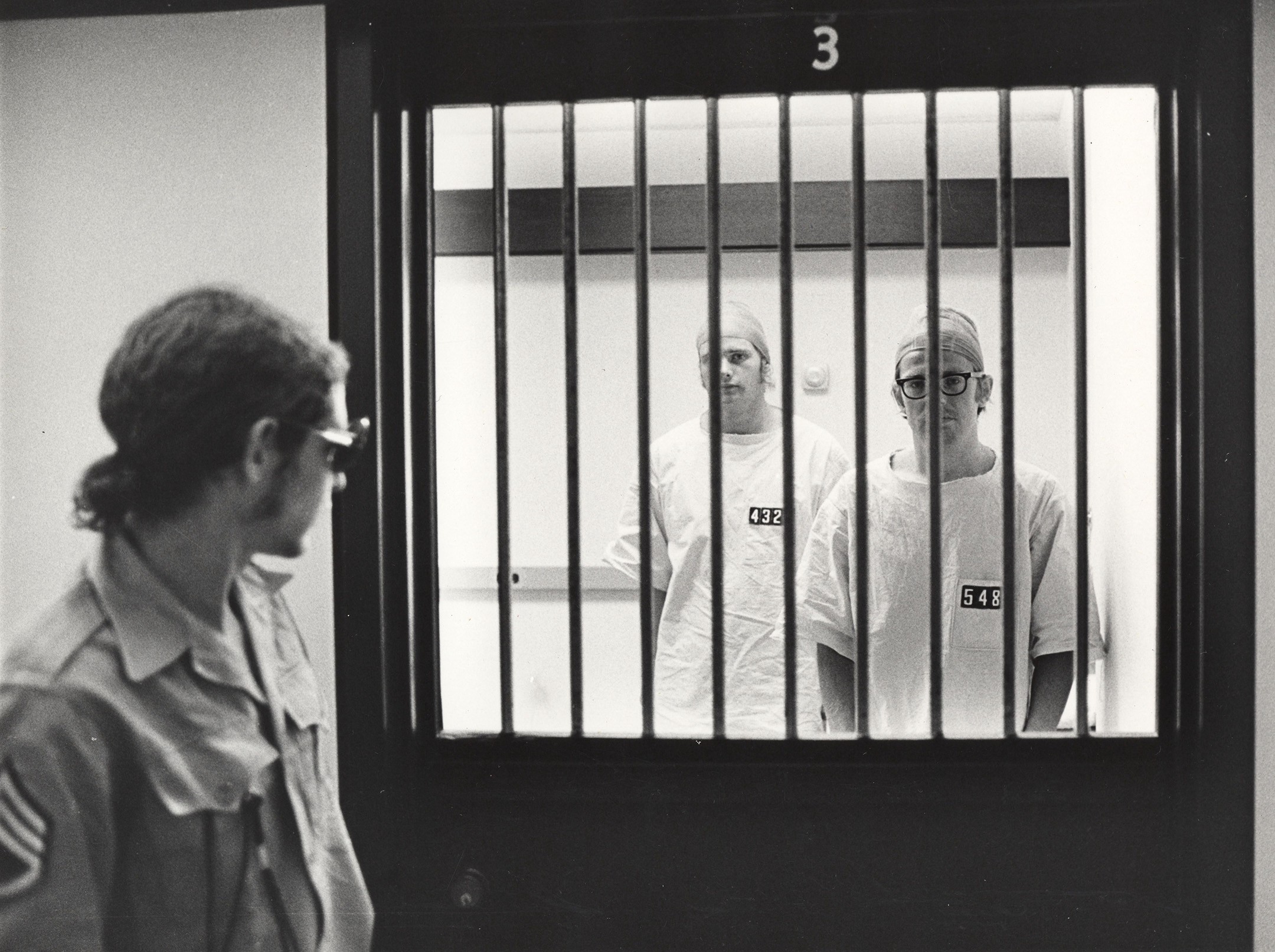 (Image/ Source: peachyessay.com)The prisoners continued to struggle with their mental health. One of them stopped eating meals and broke down in tears. Others wanted to go home. While Zimbardo and his team reminded the prisoners they could leave at any point, they refused, as they didn’t want to be seen as “bad prisoners”. So Zimbardo pushed on with the final stages of the experiment.
(Image/ Source: peachyessay.com)The prisoners continued to struggle with their mental health. One of them stopped eating meals and broke down in tears. Others wanted to go home. While Zimbardo and his team reminded the prisoners they could leave at any point, they refused, as they didn’t want to be seen as “bad prisoners”. So Zimbardo pushed on with the final stages of the experiment. (Image/ Source: cbsnews.org)Just like a real-life prison, Zimbardo wanted to create a “parole board”. But this board was made up of psychology department secretaries and graduate students. They decided to meet with certain prisoners who “thought they had grounds for parole” to observe their behaviour. However, most of the prisoners still didn’t feel like they could leave.
(Image/ Source: cbsnews.org)Just like a real-life prison, Zimbardo wanted to create a “parole board”. But this board was made up of psychology department secretaries and graduate students. They decided to meet with certain prisoners who “thought they had grounds for parole” to observe their behaviour. However, most of the prisoners still didn’t feel like they could leave. (Image/ Source: cbsnews.org)As the prisoners continued to lose their sense of reality, some of the guards decided to tone down their behaviour and act more kindly to them. This was welcomed by the prisoners. However, there were still a minority of guards that continued their harsh treatment, including one that the prisoners nicknamed “John Wayne”.
(Image/ Source: cbsnews.org)As the prisoners continued to lose their sense of reality, some of the guards decided to tone down their behaviour and act more kindly to them. This was welcomed by the prisoners. However, there were still a minority of guards that continued their harsh treatment, including one that the prisoners nicknamed “John Wayne”. (Image/ Source: prisonexp.org)At this point, Prisoner 819 was so distressed that Zimbardo himself came to speak to him. He and his psychologists removed the chain from his foot, the cap off his head, and told him to go and rest in a room that was adjacent to the prison yard. They told him they would get him some food and then take him to see a doctor.
(Image/ Source: prisonexp.org)At this point, Prisoner 819 was so distressed that Zimbardo himself came to speak to him. He and his psychologists removed the chain from his foot, the cap off his head, and told him to go and rest in a room that was adjacent to the prison yard. They told him they would get him some food and then take him to see a doctor. (Image/ Source: prisonexp.org)The other prisoners mocked Prisoner 819 as he broke down. They chanted at him through the wall of the resting room, so the psychologists called a meeting. They eventually decided to invite Prisoner 819 to leave, but Prisoner 819 was still scared to do so. Zimbardo told him: “Listen, you are not #819. You are [his name], and my name is Dr. Zimbardo. I am a psychologist, not a prison superintendent, and this is not a real prison. This is just an experiment, and those are students, not prisoners, just like you. Let's go.”
(Image/ Source: prisonexp.org)The other prisoners mocked Prisoner 819 as he broke down. They chanted at him through the wall of the resting room, so the psychologists called a meeting. They eventually decided to invite Prisoner 819 to leave, but Prisoner 819 was still scared to do so. Zimbardo told him: “Listen, you are not #819. You are [his name], and my name is Dr. Zimbardo. I am a psychologist, not a prison superintendent, and this is not a real prison. This is just an experiment, and those are students, not prisoners, just like you. Let's go.” (Image/ Source: mercurynews.com)After speaking with Zimbardo, Prisoner 819 seemed to come to his senses. He stopped crying and immediately made preparations to leave the experiment six days in. Prisoner 819’s departure led to a debate among Zimbardo and his team, as they were unsure whether they could realistically carry on with the study.
(Image/ Source: mercurynews.com)After speaking with Zimbardo, Prisoner 819 seemed to come to his senses. He stopped crying and immediately made preparations to leave the experiment six days in. Prisoner 819’s departure led to a debate among Zimbardo and his team, as they were unsure whether they could realistically carry on with the study.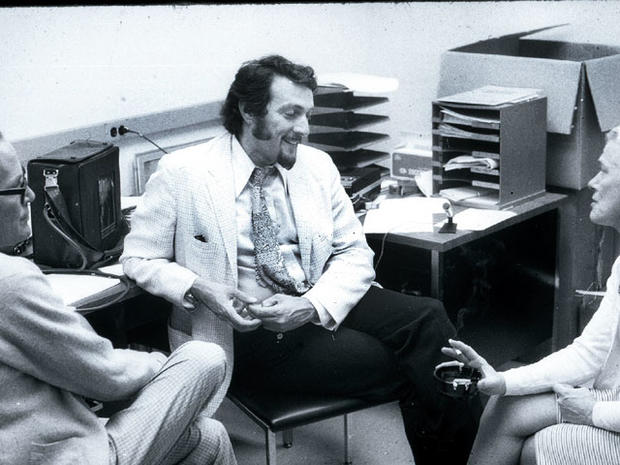 (Image/ Source: cbsnews.com)While Zimbardo and his team were still in discussions, the parents of the students taking part in the study got in touch. They were consulting with lawyers to pull their children out of the experiment, and Zimbardo was left with no choice but to abandon the study. He wanted it to run for two weeks, but it only ran for half of that time.
(Image/ Source: cbsnews.com)While Zimbardo and his team were still in discussions, the parents of the students taking part in the study got in touch. They were consulting with lawyers to pull their children out of the experiment, and Zimbardo was left with no choice but to abandon the study. He wanted it to run for two weeks, but it only ran for half of that time. (Image/ Source: cbsnews.com)Prisoners were then told that the experiment had come to an end and they were free to leave. They had no idea that this was going to happen, so at first, they found it difficult to believe. But as you can see, they were pretty happy about it in the end! But Zimbardo wasn’t quite as happy as they were- and he ended up in a lot of trouble…
(Image/ Source: cbsnews.com)Prisoners were then told that the experiment had come to an end and they were free to leave. They had no idea that this was going to happen, so at first, they found it difficult to believe. But as you can see, they were pretty happy about it in the end! But Zimbardo wasn’t quite as happy as they were- and he ended up in a lot of trouble… (Image/ Source: newscientist.com)It turned out that, despite the pleas from parents, Zimbardo had only pulled the plug on the experiment because his boss Christina Maslach, a recent Stanford PhD, strongly objected to the experiment when she saw the prisoners being abused by the guards. She was brought in to conduct interviews with the participants, but immediately ordered Zimbardo to stop. Out of fifty people present for the study, she was the only person who questioned the abuse.
(Image/ Source: newscientist.com)It turned out that, despite the pleas from parents, Zimbardo had only pulled the plug on the experiment because his boss Christina Maslach, a recent Stanford PhD, strongly objected to the experiment when she saw the prisoners being abused by the guards. She was brought in to conduct interviews with the participants, but immediately ordered Zimbardo to stop. Out of fifty people present for the study, she was the only person who questioned the abuse.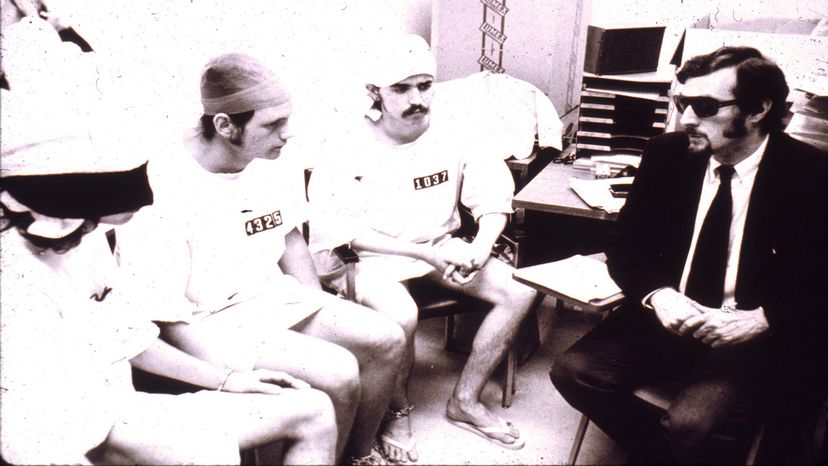 (Image/ Source: science.howstuffworks.com)Years later, this picture would haunt Zimbardo. In 2008, he wrote about his role in the experiment and said: “it wasn't until much later that I realized how far into my prison role I was at that point -- that I was thinking like a prison superintendent rather than a research psychologist.” This wasn’t something he had realised at the time.
(Image/ Source: science.howstuffworks.com)Years later, this picture would haunt Zimbardo. In 2008, he wrote about his role in the experiment and said: “it wasn't until much later that I realized how far into my prison role I was at that point -- that I was thinking like a prison superintendent rather than a research psychologist.” This wasn’t something he had realised at the time.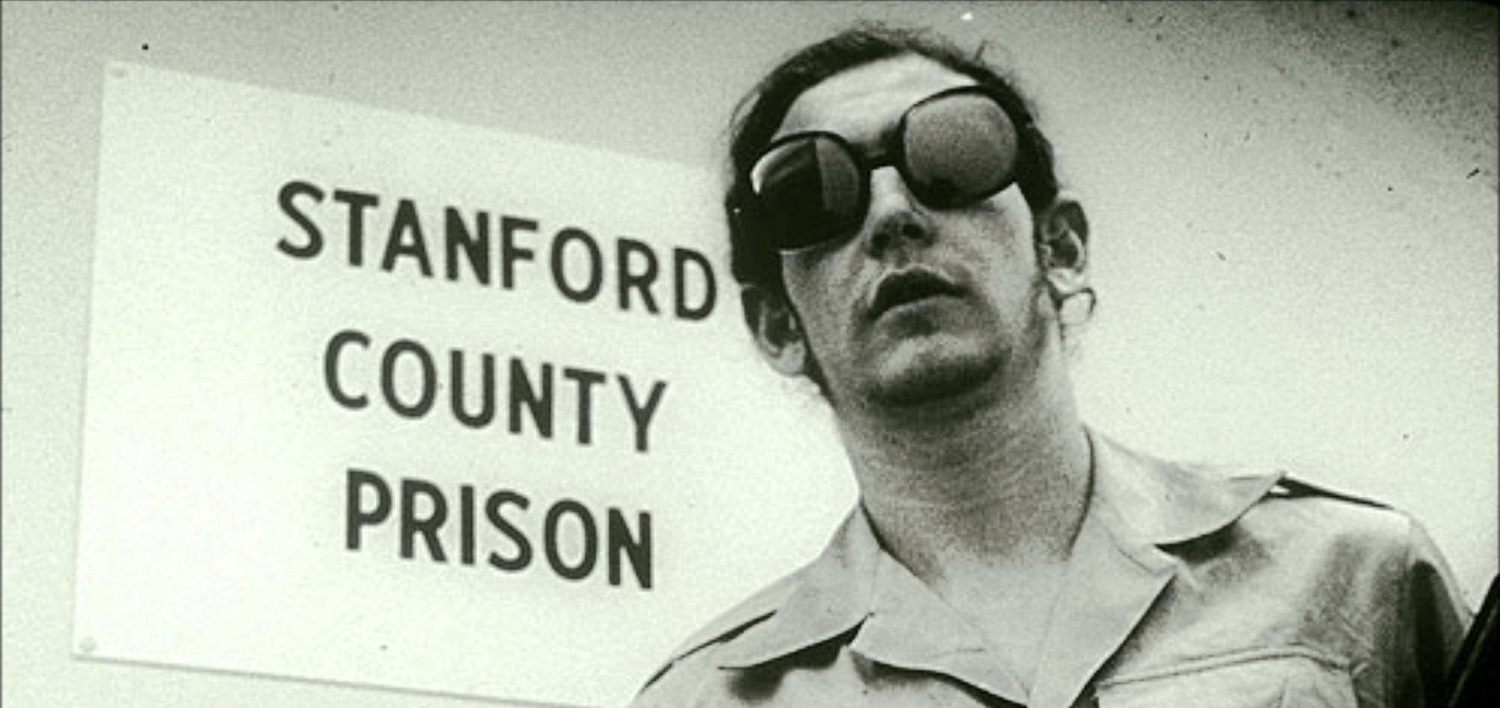 (Image/ Source: prisonexp.org)This image has been used many times to highlight some of Zimbardo’s later theories about the experiment. He pointed out that just about everyone fills the role of "prisoner" or "guard" at some point in their lives- like when a boss restricts your actions at work, or a parent disciplines a child. Zimbardo concluded that human behaviour is under situational control more than we imagine or want to believe and admit”- do you think he’s right?
(Image/ Source: prisonexp.org)This image has been used many times to highlight some of Zimbardo’s later theories about the experiment. He pointed out that just about everyone fills the role of "prisoner" or "guard" at some point in their lives- like when a boss restricts your actions at work, or a parent disciplines a child. Zimbardo concluded that human behaviour is under situational control more than we imagine or want to believe and admit”- do you think he’s right? Image Source/ PrisonExp.orgThe initial ad printed to entice male students to the psychological prison experiment - you can see the pay of $15 a day, which seems measly compared to the psychological torment they had to go through. Though, for a student, anything is better than nothing.
Image Source/ PrisonExp.orgThe initial ad printed to entice male students to the psychological prison experiment - you can see the pay of $15 a day, which seems measly compared to the psychological torment they had to go through. Though, for a student, anything is better than nothing. Image Source/ PrisonExp.orgObviously not being able to use a real prison, the people in charge of this study had to build the 'prison' ready for the study, where the participants would spend their time. Even looking at this now, it'd be hard to believe you're in a prison, but it just goes to show the psychological influence that went onto the students to begin believing they might never get out.
Image Source/ PrisonExp.orgObviously not being able to use a real prison, the people in charge of this study had to build the 'prison' ready for the study, where the participants would spend their time. Even looking at this now, it'd be hard to believe you're in a prison, but it just goes to show the psychological influence that went onto the students to begin believing they might never get out. Image Source/ PrisonExp.orgAs well as enacting a fake arrest, the prisoners would also be transported in a police car to the police station and then to the prison in the same way a real prisoner would. They didn't use any old car, as you can see, it was an authentic police vehicle.
Image Source/ PrisonExp.orgAs well as enacting a fake arrest, the prisoners would also be transported in a police car to the police station and then to the prison in the same way a real prisoner would. They didn't use any old car, as you can see, it was an authentic police vehicle. Image Source/ PrisonExp.orgThe experiment went even further in its authenticity by booking the prisoners in in the usual way, too, and not just bypassing this stage and sending them straight to their 'cell'. The prisoners were actually booked in in the same way a real prisoner would be, such as taking their fingerprints and logging them.
Image Source/ PrisonExp.orgThe experiment went even further in its authenticity by booking the prisoners in in the usual way, too, and not just bypassing this stage and sending them straight to their 'cell'. The prisoners were actually booked in in the same way a real prisoner would be, such as taking their fingerprints and logging them. Image Source/ PrisonExp.orgThis prisoner doesn't seem too phased by being blindfolded at this point, but presumably because this was the very beginning of the experiment and the student might have simply thought it was going to be a breeze. Once in the real prison conditions, being blindfolded might be more terrifying.
Image Source/ PrisonExp.orgThis prisoner doesn't seem too phased by being blindfolded at this point, but presumably because this was the very beginning of the experiment and the student might have simply thought it was going to be a breeze. Once in the real prison conditions, being blindfolded might be more terrifying. Image Source/ PrisonExp.orgBoth literal and symbolic, these shackles were attached to each man's ankle as a reminder of their imprisonment. But each student didn't just have to wear a pair of shackles - every man had one ankle shackled to the ankle of another.
Image Source/ PrisonExp.orgBoth literal and symbolic, these shackles were attached to each man's ankle as a reminder of their imprisonment. But each student didn't just have to wear a pair of shackles - every man had one ankle shackled to the ankle of another. Image Source/ PrisonExp.orgYou might say that even some real life prison cells are better than these, with a real prisoner being able to have much more space and perhaps a private cell. But here you can see how cramped together the experimental prisoners are, as well as the beds being tiny without any obvious covers to stay warm.
Image Source/ PrisonExp.orgYou might say that even some real life prison cells are better than these, with a real prisoner being able to have much more space and perhaps a private cell. But here you can see how cramped together the experimental prisoners are, as well as the beds being tiny without any obvious covers to stay warm. Image Source/ PrisonExp.orgTo make the prison experiment even more authentic, they had actual guard shifts and rotations where different 'guards' would take over shifts. It wasn't just that they left the prisoners unattended from time to time because they knew it was an experiment - there had to be a proper guard shift in place.
Image Source/ PrisonExp.orgTo make the prison experiment even more authentic, they had actual guard shifts and rotations where different 'guards' would take over shifts. It wasn't just that they left the prisoners unattended from time to time because they knew it was an experiment - there had to be a proper guard shift in place. Image Source/ PrisonExp.orgHere you can see a still from camera footage of a fire extinguisher being used and sprayed against prisoners during a revolt. It just shows as a reminder the extreme conditions and dark tactics used to treat and control prisoners in the experiment.
Image Source/ PrisonExp.orgHere you can see a still from camera footage of a fire extinguisher being used and sprayed against prisoners during a revolt. It just shows as a reminder the extreme conditions and dark tactics used to treat and control prisoners in the experiment. Image Source/ PrisonExp.orgBeing naked wasn't just for the initial booking in and strip searches, or the shower time. Some prisoners would be naked inside their cells, as you can see one prisoner here wearing no clothing and peering through his cell bars.
Image Source/ PrisonExp.orgBeing naked wasn't just for the initial booking in and strip searches, or the shower time. Some prisoners would be naked inside their cells, as you can see one prisoner here wearing no clothing and peering through his cell bars. Image Source/ PrisonExp.orgPresumably after one prisoner had left the experiment, the mattress was removed from the cell. Here you can get a closer look at what the participants had to sleep on during their time in the cell. It looks small and uncomfortable, doesn't it?
Image Source/ PrisonExp.orgPresumably after one prisoner had left the experiment, the mattress was removed from the cell. Here you can get a closer look at what the participants had to sleep on during their time in the cell. It looks small and uncomfortable, doesn't it? Image Source/ PrisonExp.orgThe prisoners did get fed, of course, and here you can see a crowded and cramped dining table set up. Although it doesn't look appealing, at least they were safe in the knowledge it would be safer than real life prison dining, where most acts of violence are bound to happen.
Image Source/ PrisonExp.orgThe prisoners did get fed, of course, and here you can see a crowded and cramped dining table set up. Although it doesn't look appealing, at least they were safe in the knowledge it would be safer than real life prison dining, where most acts of violence are bound to happen. Image Source/ PrisonExp.orgIf a prisoner left the experiment, there spot wouldn't just be left empty, it would be replaced by another prisoner. Here's a still from footage of Prisoner 416, who was a replacement prisoner in the experiment as a stand-by prisoner.
Image Source/ PrisonExp.orgIf a prisoner left the experiment, there spot wouldn't just be left empty, it would be replaced by another prisoner. Here's a still from footage of Prisoner 416, who was a replacement prisoner in the experiment as a stand-by prisoner. Image Source/ BBCEven now, years after the experiment has been over, the location of the prison experiment is marked by a plaque to commemorate what happened there. The plaque reads "SITE OF THE STANFORD PRISON EXPERIMENT, 1971".
Image Source/ BBCEven now, years after the experiment has been over, the location of the prison experiment is marked by a plaque to commemorate what happened there. The plaque reads "SITE OF THE STANFORD PRISON EXPERIMENT, 1971". Image Source / WikipediaPrisoners who applied for the job weren't just accepted on a first come, first served basis - all applications had to be properly screened so that the right candidates from the student applicants could be chosen for the experiment.
Image Source / WikipediaPrisoners who applied for the job weren't just accepted on a first come, first served basis - all applications had to be properly screened so that the right candidates from the student applicants could be chosen for the experiment. Image Source / exhibits.stanford.eduPrisoners were permitted to write letters to their loved ones, as well as family members being allowed to visit the prisoners during the experiment, and in this letter you can see reference to when the 2 week deadline is up, and how the prisoner had arranged a hunger strike that resulted in a stand-off.
Image Source / exhibits.stanford.eduPrisoners were permitted to write letters to their loved ones, as well as family members being allowed to visit the prisoners during the experiment, and in this letter you can see reference to when the 2 week deadline is up, and how the prisoner had arranged a hunger strike that resulted in a stand-off. Image Source / IMDbThe dark and curious nature of the experiment inevitably drew media attention in terms of it being made into a movie back in 2015. The movie depicts the experiment with the guards, prisoners and the man behind it all. The movie has good reviews as well as references to the obvious chilling idea behind it all.
Image Source / IMDbThe dark and curious nature of the experiment inevitably drew media attention in terms of it being made into a movie back in 2015. The movie depicts the experiment with the guards, prisoners and the man behind it all. The movie has good reviews as well as references to the obvious chilling idea behind it all. Image Source / BuzzfeedYou can see by the smiles on the prisoners' faces that at the beginning of it all, it must have seemed more like a casual experiment or more of a laugh than they ever could have imagined. This was before all the bag-wearing, strip-downs and gruelling conditions began.
Image Source / BuzzfeedYou can see by the smiles on the prisoners' faces that at the beginning of it all, it must have seemed more like a casual experiment or more of a laugh than they ever could have imagined. This was before all the bag-wearing, strip-downs and gruelling conditions began. Image Source / The Stanford DailyThere must have been something even more terrifying to this with the fact that it was an experiment - even in a normal prison you know there's some sense of routine and order, but to have a bag put over your head while taking part in a psychological prison experiment must have left these men scared.
Image Source / The Stanford DailyThere must have been something even more terrifying to this with the fact that it was an experiment - even in a normal prison you know there's some sense of routine and order, but to have a bag put over your head while taking part in a psychological prison experiment must have left these men scared. Image Source / The Stanford DailyDespite some pictures revealing naked prisoners and strip searches, you can see here during a prison line up that they were at least afforded flip flops to wear when moving around - at least at the very beginning, anyway, as the shackles don't yet look to have been locked onto the feet here...
Image Source / The Stanford DailyDespite some pictures revealing naked prisoners and strip searches, you can see here during a prison line up that they were at least afforded flip flops to wear when moving around - at least at the very beginning, anyway, as the shackles don't yet look to have been locked onto the feet here...